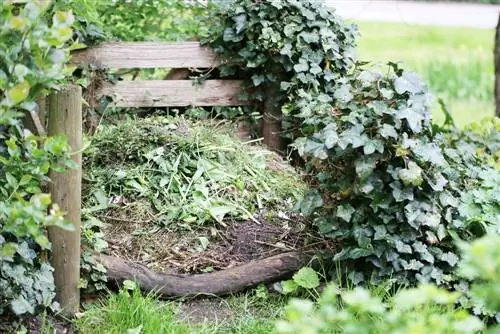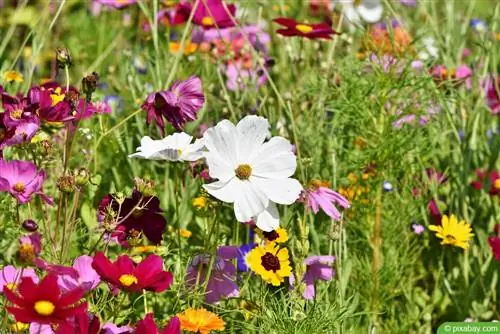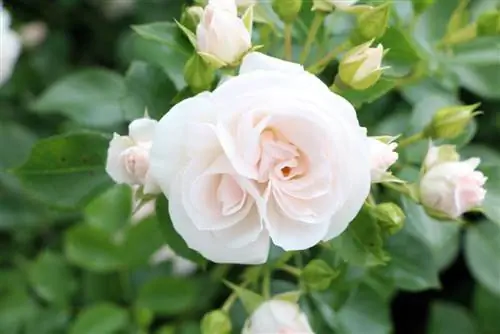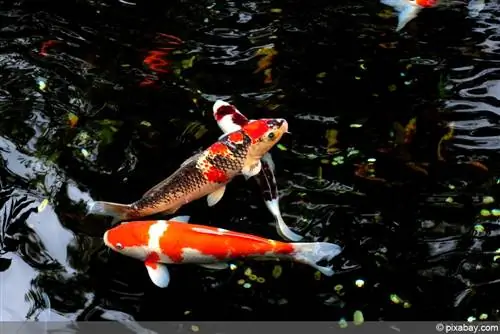- Author admin [email protected].
- Public 2023-12-17 03:39.
- Last modified 2025-01-24 12:45.
In perfectly organized nature, nothing is wasted. She continually reassembles the building blocks of life. Anyone can take advantage of this. Especially every garden owner. Add vegetable waste to the compost heap. Get fine and nutrient-rich soil back. It's so easy to save money on more expensive fertilizer. Find out what else you need to know about composting here.
Various material variants
Wood, metal and plastic are the three main materials used to make compost bins. The individual materials differ greatly in their properties. Decide for yourself which variant you prefer.
- a wooden compost bin looks natural
- However, wooden slats rot over time
- Slats need to be replaced occasionally
- Metal grilles are more durable
- a coating protects against rust
- Thermal composters made of plastic accelerate rotting
- small models fit in every garden
- Plastic is not particularly visually appealing
Tip:
Skilled property owners can also build a compost bin firmly into the wall. Hardware stores sell special stones that ensure adequate ventilation.
Optimal number and size
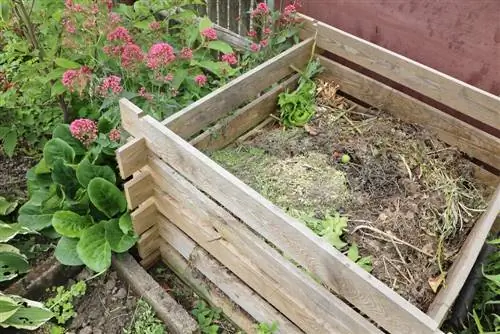
The rotting process in a compost heap is promoted by turning it over. This work is easiest to carry out if there are several compost bins in a garden at the same time. In addition, there should always be free capacity to accommodate all plant waste that is constantly generated. A number of containers of three has proven to be optimal. A compost bin itself is well sized at around one cubic meter. The length, height and depth are then each one meter.
Suitable location
Sun, wind and rain affect the compost heap, changing the temperature and humidity. This is definitely helpful for the work of the microorganisms. But the compost heap as a “living system” does not like extremes in this regard. Depending on the weather conditions, rot or drying out can quickly occur. The orderly conversion process comes to a h alt. A location that allows him to feel the capricious weather attenuated is ideal:
- no continuous blazing sun
- no total shadow
- Penal shade is optimal
- House wall, garden hedge or a tall tree offer protection
- Protected from the wind, but not windless
- because enough fresh air is necessary
Tip:
Compost bins are often placed on the edge of the property. There's nothing wrong with that either. However, in the spirit of being a good neighbor, you should maintain an appropriate distance from the property line.
Ideal surface for a compost bin
When the compost bin is set up, care must be taken to provide free access to the microorganisms. They are the decisive factor in the decomposition work and must be able to find their way into the container quickly and easily. This only works if the compost container is placed directly on the ground. For example, earthworms from the garden can migrate deep into the compost interior. Sealed surfaces such as concrete, stone or asph alt are not suitable for setting up a composter as they prevent direct contact with living soil.
Start composting correctly
First, the subsoil under the compost container should be loosened with a digging fork. The first thing that goes in is coarse plant material. Small cut twigs and chopped branches are ideal for this layer. It should be a maximum of 20 cm high. Only then do the finer materials, such as vegetable and fruit waste, follow. The more diverse the plant remains, the better.
This can end up in the compost heap
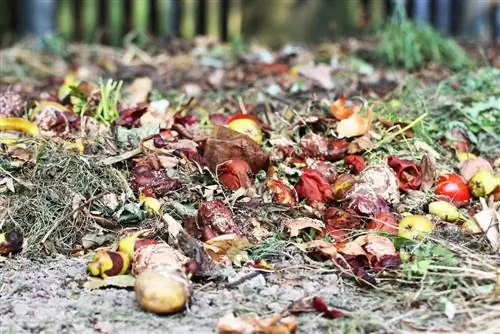
Not everything of plant origin is safe in a compost heap. Below is a brief overview of what can go into the compost without hesitation.
- raw fruit and vegetable waste
- Tea bags and coffee filters including coffee
- Eggshells
- Lawn clippings, dried and in small quantities
- Shrub and tree pruning
- Litter and straw
- Leaves
- Sawdust
Tip:
The Federal Environment Agency offers the free brochure “Compost Guide” on its website. It contains a lot of information that makes composting understandable and easier.
This doesn't belong in the compost bin
Everything that does not come from a plant cannot and must not be composted. In addition, there are plant remains that rot very difficult. Even cooked vegetables or fruits have no place in the compost heap. To clarify, here are a few examples:
- Plastic
- Glass
- Metal
- Cat Litter
- Ashes
- cooked leftovers
- non-vegetable leftovers
- Citrus fruits in larger quantities
- diseased plant parts
- Coniferous trees
Tip:
Be careful with pulled weeds. Ripe seeds can survive the implementation process in the compost in one piece. As soon as the ripe compost is distributed in the garden, new weeds sprout from it.
Different Layers
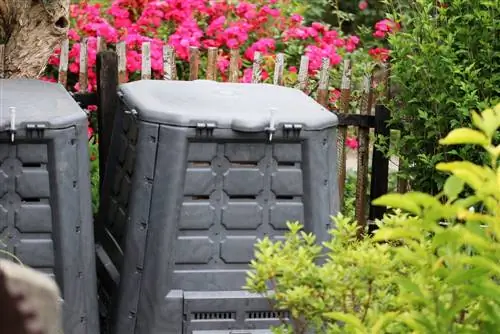
Not only the content is crucial, the quantity and composition also play an important role. To ensure that the composting process runs smoothly, diversity in the starting material is helpful.
- various components are beneficial
- dry and wet material should alternate
- also coarse and fine plant residues
- individual components should not be added in large quantities at once
- A maximum of 20 cm layer of one component is permitted
- this should be followed by a different type of plant material
Oak leaves and walnut leaves rot very slowly. They should not be composted at all or only in small quantities.
Shredding large pieces
The plant material produced in the garden is often a challenge for decomposing microorganisms. At least if it ends up in the compost without prior processing. Twigs, branches and stems are simply an enormously large portion that takes a lot of time to decompose. It works much faster if hard and bulky plant material is first broken into smaller pieces.
- cut small quantities with secateurs
- A lot is left over after cutting trees and bushes
- A chipper is helpful here.
Tip:
Only a limited amount of this waste component should be added to the compost heap at one time. If there is a lot of shredded wood material, it can also be scattered under trees and bushes.
Accelerate the rotting process
Impatient gardeners like to help their compost heap so that it supplies them with fine compost as soon as possible. In order to significantly shorten the rotting time, the following remedies are often used:
- commercially available compost accelerator
- so-called compost starter
- Lime
- Rock flour
- Bacterial preparations
These funds all cost money that does not necessarily have to be spent. A well-mixed compost heap contains both coarse and hard materials as well as fine and soft materials. This is enough for smooth decomposition. If you still want to gain some time, you can do so with a few simple tools that are available free of charge in the garden. The following additions also have an accelerating effect.
- ripe compost
- coarse sifted compost
- Garden soil
A few scoops of it contain enough microorganisms that act as a kind of vaccination and continue to multiply in the compost.
Turning compost heap
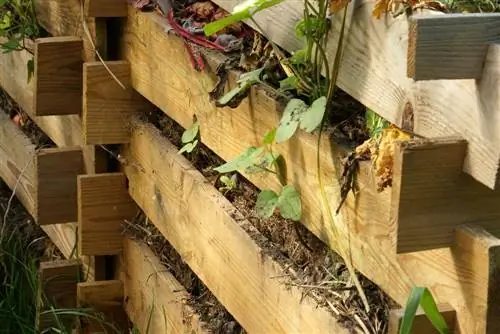
A compost heap is constantly changing. Old material gradually rots away and new plant material is constantly being added. Over time it grows into a considerable mountain. Now ventilation can no longer be uniform everywhere. If the compost heap is moved, it has two advantages:
- the compost is aerated
- the volume is reduced
- the rotting process is shortened
Turning can be done by transferring the still immature compost from one container to another. The layers are literally turned upside down. Moving within a container is a little more difficult and time-consuming, but it is possible.
Note:
Even compost heaps that are not turned over at all will eventually turn into fine compost. If you can wait patiently, you can save yourself the work of moving things.
The right time to implement it
Most greenery occurs in summer and autumn. The microorganisms then have several months to do their work in peace. The half-finished compost heap is only moved in spring, as soon as the first warm days appear and the ground is no longer frozen. The compost can be put through a sieve to separate fine soil from coarse pieces. The rough portion is implemented, while the rest is allowed to nourish the plants.
More tips about composting
- Coffee grounds, leftover tea and onion peels attract beneficial earthworms.
- Keep compost moist to maintain the biological balance. Water on hot days, but do so carefully, because too much moisture is not good either.
- It is better to put waste that attracts vermin in the organic waste bin. This particularly concerns leftover food and meat.
- Ensure good ventilation, using a compost bin that has appropriate openings.
- A finished pile on which no more plant waste is piled should be covered with wood or leaves. This prevents drying out or getting wet.

